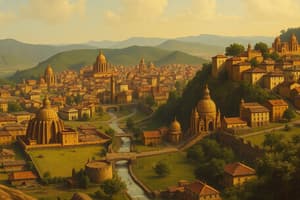Podcast
Questions and Answers
What were the primary economic activities of the Indus Valley Civilization?
What were the primary economic activities of the Indus Valley Civilization?
- Mining, hunting, and pottery
- Weaving, metalwork, and trade
- Agriculture, fisheries, and animal husbandry (correct)
- Construction, jewelry-making, and fishing
In terms of social structure, what was a distinguishing feature of the early Harappan society?
In terms of social structure, what was a distinguishing feature of the early Harappan society?
- Social equality (correct)
- Rigid caste system
- Hereditary professions
- Division based on wealth
Which region did the Indus Valley Civilization engage in trading activities with?
Which region did the Indus Valley Civilization engage in trading activities with?
- Persia and India
- Mesopotamia and Elam (correct)
- China and Egypt
- Greece and Rome
What kind of workshops existed in the Indus Valley Civilization that produced pottery, metalware, and textiles?
What kind of workshops existed in the Indus Valley Civilization that produced pottery, metalware, and textiles?
What was a significant achievement in terms of technology for the Indus Valley Civilization?
What was a significant achievement in terms of technology for the Indus Valley Civilization?
What artifact from Mohenjodaro suggests an advanced understanding of mathematics in the Indus Valley Civilization?
What artifact from Mohenjodaro suggests an advanced understanding of mathematics in the Indus Valley Civilization?
Study Notes
Indus Valley Civilization
Trade and Economy
The Indus Valley Civilization thrived around 2600 BCE and lasted until around 1900 BCE. The economy of this civilization was based on agriculture, fisheries, and animal husbandry, with crops such as wheat, barley, rice, and pulses being grown. They were also involved in extensive trading activities, with evidence suggesting exchanges of goods with neighboring regions like Mesopotamia and Elam. The Indus Valley Civilization had an impressive network of roads, enabling efficient transport of goods.
Social Structure
Unlike the rigid caste systems of later Indian civilizations, the early Harappan society showed signs of social equality. However, there is evidence of wealth disparities, with wealthy individuals having access to finer quality goods and services. The societal structure appears to have been divided into urban and rural populations, with the former being more elite in nature.
Technology and Craftsmanship
The Indus Valley Civilization was highly advanced for its time. They created standardized systems of measurement using tools like ivory scales and had specialized workshops that produced various items such as pottery, metalware, and textiles. This civilization also had an impressive understanding of mathematics, which is evident from the discovery of a granite ball from Mohenjodaro with 44 lines engraved on it, suggesting mathematical calculations.
Art and Artifacts
Indus Valley Civilization artifacts include terracotta figurines, bronze sculptures, and gold jewelry. These objects often depict scenes of daily life, religious ceremonies, and hunting activities. Notable finds include the "Dancing Girl," a small bronze figure representing a female dancer, and the "Priest-King," an image of a bearded man wearing robes.
Urban Planning
The Indus Valley Civilization cities were well planned, with streets laid out in a grid pattern, public baths, drains, and water supply systems. There are indications of city planning based on astronomical observations, with some cities arranged along east–west axes. The cities were fortified, possibly indicating defense against external threats.
Studying That Suits You
Use AI to generate personalized quizzes and flashcards to suit your learning preferences.
Description
Explore the aspects of trade and economy, social structure, technology and craftsmanship, art and artifacts, and urban planning in the Indus Valley Civilization. Learn about their agricultural practices, trading networks, societal divisions, advanced craftsmanship, and well-planned cities.




